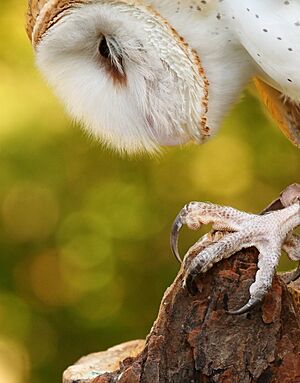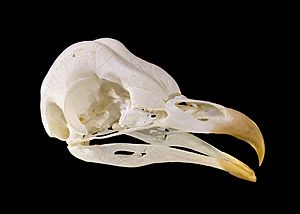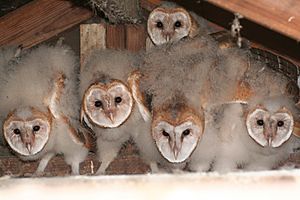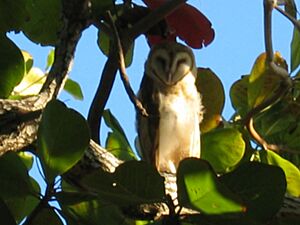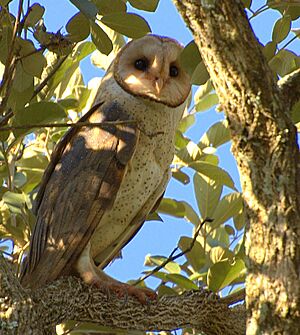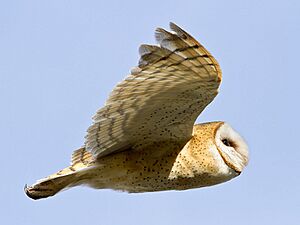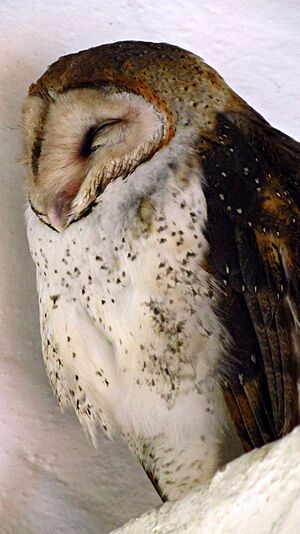American barn owl facts for kids
Quick facts for kids American barn owl |
|
|---|---|
 |
|
| Tyto furcata in Utah | |
| Scientific classification | |
| Subspecies | |
|
Many, see text |
|
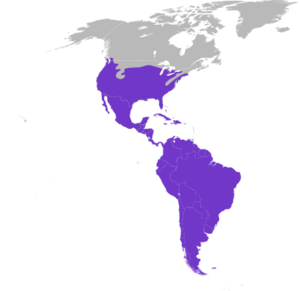 |
|
| Synonyms | |
|
Strix pratincola Bonaparte, 1838 |
The American barn owl (Tyto furcata) is a type of barn owl. It lives in North and South America. People have also brought it to Hawaii. Some scientists think it is a separate species. Other scientists group it with other barn owls around the world.
The ashy-faced owl (T. glaucops) was once thought to be the same as T. alba. Some still group its populations from the Lesser Antilles with T. alba. But DNA studies show that the American barn owl (T. furcata) is its own species. The Curaçao barn owl (T. bargei) is also now seen as a separate species.
Contents
- What Does the American Barn Owl Look Like?
- How Do Barn Owls Live? (Behavior and Ecology)
- =What Do Barn Owls Eat? (Diet and Feeding)
- How Barn Owls Reproduce (Breeding)
- How Barn Owls Change Feathers (Moulting)
- Who Hunts Barn Owls? (Predators and Lifespan)
- Types of American Barn Owls (Subspecies)
- How We Protect Barn Owls (Status and Conservation)
What Does the American Barn Owl Look Like?
The American barn owl is a medium-sized owl. It has pale feathers, long wings, and a short, square tail. The largest barn owl is T. f. furcata. This owl lives in Cuba and Jamaica. It is bigger because it has more food and fewer other owls to compete with.
Feathers and Face of the Barn Owl
You can tell a barn owl from other owls by its tail shape when it flies. It also has a wavy flight and dangling, feathered legs. Its pale face is heart-shaped with black eyes. This makes it look like it's wearing a mask.
The owl's head and upper body are usually light brown or grey. Some are a richer brown. They all have tiny black and white spots. The main wing feathers are light brown with darker bands. The heart-shaped face is often bright white. Some subspecies have a brown face.
The feathers on its belly and lower legs can be white or reddish-brown. They might have tiny blackish-brown spots. Female owls with more spots are often healthier. Male owls usually have fewer spots and are paler than females. Females are also larger. A large female can weigh over 550 g (19 oz). Males are usually about 10% lighter. Baby owls are covered in white down feathers. Their heart-shaped face appears soon after they hatch.
Where Do Barn Owls Live?
In the United States, barn owls usually move 80 and 320 km (50 and 199 mi). Some travel as far as 1,760 km (1,094 mi) from where they were born. Barn owls were brought to Kauai in Hawaii to control rodents. But they also eat native birds there.
How Do Barn Owls Live? (Behavior and Ecology)
Like most owls, the barn owl hunts at night. It uses its excellent hearing to find prey in the dark. It often becomes active just before sunset. Sometimes you can see it during the day when it moves to a new resting spot.
Barn owls do not defend a specific territory. Instead, they have a home range where they hunt for food. Female owls usually share the same home range as their mates. When they are not breeding, males and females often rest separately. Each owl has about three favorite spots to hide during the day. They also visit these spots briefly at night.
Resting spots include holes in trees, cracks in cliffs, and old buildings. They also use chimneys and hay sheds. These spots are often small compared to their nesting sites. When it's time to breed, the owls move closer to their chosen nest to rest.
Where Barn Owls Hunt
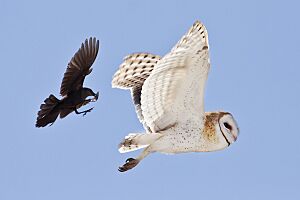
This owl lives in open areas like farms or grasslands. It likes places with some scattered trees. They usually live below 2,000 metres (6,600 ft) in height. But in tropical areas, they can be found as high as 3,000 metres (9,800 ft). This owl prefers to hunt along the edges of woods. It also hunts in grassy strips next to pastures.
It flies smoothly and quietly over the ground. It listens for sounds made by animals it can eat. Barn owls fly silently. Tiny bumps on the front edges of their wing feathers help break up the air flow. This reduces noise. Hair-like fringes on the back edges of their feathers also help. These features make their flight quiet. Soft, hair-like extensions on their feathers also reduce noise from wingbeats.
=What Do Barn Owls Eat? (Diet and Feeding)
Scientists have studied what barn owls eat a lot. They can tell what the owl ate by looking at the undigested parts it spits up. These are called pellets. In most places, over 90% of their food is small mammals. But in hot, dry areas, they eat many other creatures. This depends on what is available.
They mostly eat animals that live on the ground. But they also catch bats and birds. They eat lizards, amphibians, and insects too. Even when earthworms are common, barn owls do not seem to eat them.
In North America, voles are their main food. Shrews are the second most common. On an island off California, young owls were fed Leach's storm petrels. Barn owls mostly eat rodents and other small mammals. These usually make up 95% of their diet in the United States. Worldwide, it's over 90%.
How Barn Owls Hunt
The barn owl hunts by flying slowly over the ground. It also hovers over spots where prey might be hiding. It can also sit on branches or fence posts to look for food. Its long, wide wings help it turn quickly. Its long, thin legs and toes help it hunt in thick plants or under snow. They also give it a wide grip when it attacks prey.
One barn owl can eat one or more voles each night. This is about 23% of its body weight. Barn owls often hide extra food at their resting spots. They can use this food when it's hard to find more.
Small prey is usually torn into pieces and eaten whole. This includes bones and fur. Barn owls do not usually eat farm animals. In some areas, they eat other foods if rodents are scarce. On islands with many birds, a barn owl might eat 15-20% birds. In grasslands, it might eat swarming termites or crickets. Bats, frogs, lizards, and snakes can also be a small part of their diet.
The barn owl has amazing hearing. Its ears are placed unevenly. This helps it figure out where sounds are coming from. It does not need to see to hunt. Its facial disc also helps with hearing. If the feathers around its face are removed, it can still tell the direction of a sound. But it can't tell if the sound is higher or lower.
This bird hunts at night or at dawn/dusk. It can pinpoint its prey and dive to the ground. It can grab small creatures through snow, grass, or bushes with great accuracy. Compared to other owls its size, it needs more food. They eat more rodents, which are often seen as pests by humans. This makes the barn owl very helpful for farmers. Farmers often find these owls better than poison for controlling rodents.
How Barn Owls Reproduce (Breeding)
Barn owls in warm, tropical places can breed any time of year. But they often lay eggs during the dry season. This is when more rodent prey is available. In dry areas, breeding might happen only during wet periods. This is when small mammal numbers increase. In cooler climates, breeding seasons are more specific. There are times of the year when no eggs are laid. In North America, most nesting happens between March and June. This is when temperatures are rising. The exact dates depend on the year and location. It also depends on how much good hunting ground is near the nest. It often matches the cycle of rodent numbers.
Female owls can breed when they are 10 to 11 months old. Males sometimes wait until the next year. Barn owls usually stay with one partner for life. They only find a new mate if one dies. When not breeding, they might rest separately. But as breeding season nears, they return to their nesting site. They often use the same nest year after year.
In colder places, they might rest in farm buildings or hay bales during harsh weather. But then another bird might take their nesting hole. Single males might set up hunting areas. They fly around, hover, and screech from high spots to attract a mate. If a female loses her mate but keeps her nest, she usually finds a new one.
Courtship and Nesting
Once a pair is formed, the male flies short distances around the nest at dusk. Then he makes longer flights to mark his home range. When the female joins him, they chase and twist in flight. They make frequent screeches. The male's screech is high-pitched. The female's is lower. Later, the male flies high into the sky at dusk. Then he swoops back down fast near the female. He then goes to hunt. The female sits in a high spot and cleans her feathers. She returns to the nest a minute or two before the male brings her food. The male feeding the female is common. It helps them bond and makes the female stronger before she lays eggs.
Barn owls nest in holes. They choose holes in trees, cracks in cliffs, or large nests of other birds. They also use other structures. Tree nests are usually in open areas, not deep in forests. Nests in North America are often higher up. This is to avoid predators like raccoons.
They don't use nesting material. But as the female sits on the eggs, she pulls in dry, furry bits from her regurgitated pellets. So, by the time the chicks hatch, they are surrounded by a carpet of shredded pellets.
Before laying eggs, the female stays near the nest. The male brings her all her food. The male also rests nearby and might hide any extra prey. When the female is at her heaviest, the male gives her food as a ritual. The female lays eggs every other day. A clutch usually has about five eggs. It can range from two to nine. The eggs are chalky white and oval-shaped. They are about the size of bantam's eggs. Incubation starts as soon as the first egg is laid. While she sits on the nest, the male keeps bringing food. It might pile up next to her.
Hatching and Raising Young
Incubation lasts about 30 days. Chicks hatch over a long time. The youngest chick might be several weeks younger than the oldest. In years with plenty of food, about 75% of eggs hatch successfully.
The chicks are first covered with greyish-white down. They grow quickly. Within a week, they can hold their heads up and move around the nest. The female tears up the food the male brings and gives it to the chicks. At first, they make a "chittering" sound. This soon changes to a "snore" when they want food. By two weeks old, they are half their adult weight. They look naked because their down feathers don't cover their growing bodies.
By three weeks old, new feathers start to grow. The chicks stand up. They make snoring noises with raised wings and wiggling tail stumps. They beg for food, which is now given whole. The male brings most of the food until all chicks are at least four weeks old. Then the female starts to leave the nest and rest elsewhere. By the sixth week, the chicks are as big as adults. But they slim down by the ninth week. This is when they are fully feathered and start leaving the nest briefly. They still depend on their parents until about 13 weeks old. The female trains them to find and catch prey.
How Barn Owls Change Feathers (Moulting)
Feathers wear out over time. All birds need to replace them. Barn owls need to fly quietly and well. In cooler areas, their feather change (moult) takes two years. It happens in three stages. The female starts moulting while she is sitting on eggs and caring for chicks. During this time, the male feeds her, so she doesn't need to fly much. The first main wing feather to fall out is number 6. It grows back completely by the time the female starts hunting again. Feathers 4, 5, 7, and 8 fall out around the same time the next year. Feathers 1, 2, 3, 9, and 10 fall out in the bird's third year. The secondary and tail feathers are lost and replaced over a similar time. This also starts during incubation. For the tail, the two outer feathers fall out first, then the two central ones. The other tail feathers moult the next year.
In cooler areas, male owls moult later in the year than females. This is when there is plenty of food. The female has started hunting again, and the chicks need less food. Males without a mate or family often start losing feathers earlier. The male's moult also takes a long time. The first sign a male is moulting is often a tail feather dropped at the roost. Losing feathers means losing warmth. This is not a problem in tropical areas. Barn owls there usually moult all their flight feathers every year. The moult in hot climates can still take a long time. But it usually happens at a specific time of year when they are not breeding.
Who Hunts Barn Owls? (Predators and Lifespan)
Predators and Dangers
Animals that hunt barn owls include large opossums, common raccoons, and other meat-eating mammals. Larger birds like eagles, hawks, and other owls also hunt them. The great horned owl is a known predator of barn owls. One study found that 10.9% of the great horned owl's diet was barn owls.
When a barn owl is bothered at its resting spot, it lowers its head. It sways its head from side to side. Or it might lower its head and stretch it forward. It also droops its wings. It makes hissing sounds and snaps its beak. To defend itself, it might lie flat on the ground or crouch with its wings spread out.
How Long Do Barn Owls Live?
Wild barn owls usually do not live very long. But they have many babies that grow fast. Many of these young owls do not survive to adulthood. However, barn owls in zoos can live for twenty years or more. Sometimes, a wild bird lives a long time. The longest a wild barn owl has lived in America is eleven and a half years. Including these very old birds, the average lifespan is about four years. About two-thirds to three-quarters of adult owls survive from one year to the next.
The main reason barn owls die in cooler areas is starvation. This is especially true in autumn and winter. Young birds are still learning to hunt then. In northern and mountain areas, bad weather, deep snow, and long cold periods can kill older birds. Hitting cars on roads is another cause of death. This can happen when birds hunt on grassy areas next to roads. Some of these birds are not healthy. They might not be able to avoid cars as well as healthy owls. In the past, many owls died from pesticides. This might still happen in some parts of the world. Hitting power lines also kills some birds.
Types of American Barn Owls (Subspecies)
Here are some different types of American barn owls:
| Subspecies | Description | Where They Live | Other Names |
|---|---|---|---|
| T. f. furcata (Temminck, 1827) | Large. Pale orange-brown and brownish-grey on top. Whitish underneath with few spots. White face. | Cuba, Jamaica, the Cayman Islands (rare or gone from Grand Cayman). | Caribbean barn owl |
| T. f. tuidara (J.E. Gray, 1829) | Grey and orange-brown on top. Whitish to light brown underneath with few spots. White face. | South American lowlands east of the Andes and south of the Amazon River all the way to Tierra del Fuego; also on the Falkland Islands. | |
| T. f. pratincola (Bonaparte, 1838) | Large. Grey and orange-brown on top. Whitish to light brown underneath with many spots. White face. | North America from southern Canada to central Mexico; Bermuda, the Bahamas, Hispaniola; brought to Lord Howe Island (but died out) and in 1958 to Hawaii (where it still lives). | North American barn owl |
| T. f. punctatissima (G. R. Grey, 1838) | Small. Dark greyish-brown on top, with clear white spots. White to golden-brown underneath, with clear brown patterns or fine dense spots. | Only on the Galápagos Islands. | Galápagos barn owl |
| T. f. guatemalae (Ridgway, 1874) | Similar to dark pratincola; less grey on top, rougher spots underneath. | Guatemala or southern Mexico through Central America to Panama or northern Colombia; the Pearl Islands. | |
| T. f. bargei (Hartert, 1892) | Similar to alba; smaller and with very short wings. | Only on Curaçao and maybe Bonaire in the West Indies. | Curącao barn owl |
| T. f. contempta (Hartert, 1898) | Almost black with some dark grey on top, with clear white spots. Reddish-brown underneath. | Northeastern Andes from western Venezuela through eastern Colombia south to Peru. | |
| T. f. hellmayri (Griscom & Greenway, 1937) | Similar to tuidara, but larger. | Northeastern South American lowlands from eastern Venezuela south to the Amazon River. | |
| T. f. bondi (Parks & Phillips, 1978) | Similar to pratincola; smaller and paler. | Only on Roatán and Guanaja in the Bay Islands. | |
| T. f. niveicauda (Parks & Phillips, 1978) | Large. Similar to furcata; paler overall. | Only on Isla de la Juventud. |
How We Protect Barn Owls (Status and Conservation)
Barn owls are quite common in most places they live. They are not seen as globally endangered. However, in some areas, their numbers have dropped a lot. This was due to poisons like DDT in the mid-1900s. Later, rodent poisons in the late 1900s also affected them. Modern farming often removes the rough grasslands where they hunt best.
Barn owls have many babies and can recover from short-term population drops. But they are not as common in some areas as they used to be. In the US, barn owls are listed as an endangered species in seven states in the Midwest.
In some places, there might not be enough good nesting spots. Providing nest boxes under building eaves or in other places can greatly help increase the local barn owl population.
Some old names for barn owls are "demon owl," "death owl," or "ghost owl." This shows that in the past, people in rural areas sometimes thought barn owls brought bad luck.


